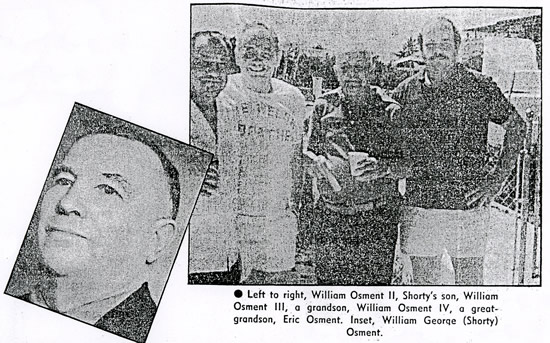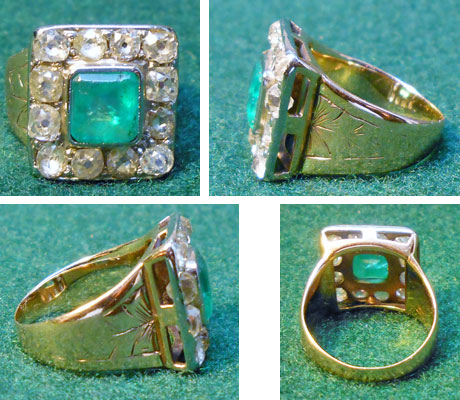Power of the Santos Ring
In 1875 a schooner anchored off Brazil affected by the deadly yellow fever.
Aboard was the relative of a South Wales man who was destined for fame and fortune.
Was it sheer coincidence that he prized one possession?
By Jim Dyer
First published in the Western Mail 1987
© Jim Dyer 2012

South Wales man, Eric Osment, had the shock of his life when he stepped into the sunny Florida shore to be greeted by long-lost relatives bearing a remarkable resemblance to himself.
Former merchant navy war veteran, Eric Osment, was even more taken aback when he was shown photographs of other relatives on the exotic Caribbean island of Cuba; black-skinned they may have been, but there was no mistaking the uncanny facial similarities.
Eric, a retired fitter living in Rogerstone, Gwent, always had a yearning to find out if there was any truth in the tales his father, Bill, told him about his American millionaire ancestor, William George Osment.
Little did he realise his search would take him across the oceans he had travelled as a humble engineer aboard ship, or introduce him to background of adventure, wealth and mystery.
Eric and wife June live in the quiet cul-de-sac of Ifor Hael Road, a long way from the swampy wetlands of mainland Florida or the wild sugar plantations of Cuba. But it was in America that he was to learn a strange, but true, tale about one of the most wealthy businessmen with an entrepreneurial skill rarely matched - even today.
William George Osment, the millionaire vice-president and director of the Guantanamo and Western Railroad of Cuba died in Miami in 1946, well into his eighties. This was not long after Eric on the Welsh side had returned from the gruelling service steaming the Arctic convoys in world war II.

'Shorty' Osment - William George Osment - in 1945
Photo courtesy of Norm Sutton, Grandson of 'Shorty'.
This rumbustious character, affectionately known as 'Shorty', certainly had the Midas touch with money, making his fortune building railroads and owning extensive sugar and fruit investments with his own steamers to transport the goods throughout the world.
First Adventures
Born just across the Bristol Channel, William first went to the Americas in 1875 as a young sailor aboard a square-rigged schooner. His exciting adventures started when his ship anchored off Santos, Brazil. It was here too that Shorty's luck changed for the better and the strange tale of the Santos Ring begins.
Eric told me about the diamond ring which his ancestor had never parted from. 'He always believed it brought him good luck and judging by his successful career this could have been the case. Shorty came by the ring in strange circumstances. His ship was in a bad way when it anchored at Santos plagued with fever and this terrible affliction was rife in the town as well. The crew were dying one by one, and Shorty, terrified, knew he had to get away from the rat-infested ship.'
William decided to make a break for it and fully clothed dived into the sea and swam to the shore. The beach was covered in dead bodies, victims of the incurable fever, and he set out for a clear place. exhausted he fell asleep to be woken by a native woman who became his companion for a while. He headed into the jungle finding food and shelter where he could, and came across a Hindu mystic who could speak English and read the future.
'It was not long before the personable Shorty and the mystic became friends and, as the mystic lay dying, he told Shorty that though he would experience hardship and bloodshed he would become a great success with money,' Eric told me. 'The dying man gave Shorty his ring – solid gold with a big diamond – but warned him never to lose it. It would attract success but if he lost it, he would lose everything, maybe his life.' This is the tale handed down from generations and it is a fact that William had a diamond ring which he treasured.
He took the ring and from that day never looked back. Those who knew him in later years vouched that it never left his finger.
He went from strength to strength, travelling many roads but always avoiding serious illness and amassing a considerable fortune in the process. His hunches always paid off. He became a superintendent building a 200 mile railroad from Madeira to Mamore through the grim Brazilian jungle in 1876, a project which initially failed but was eventually completed in 1909. From day one Shorty was there and though 30,000 lives were lost building it he never had one day's illness.
Continued Success
Passing through Latin revolutions, Shorty eventually married a Cuban girl and made his home in Boqueron, where he built and owned a railroad running to Guantanamo City. He branched out into sugar cane, coconuts, fruit and vegetables, his fleet of steamers voyaging to world markets.
At the outbreak of the Spanish/American war he enlisted in the army and was in charge of supply trains in the early part of the conflict. He came through unscathed, his already tidy fortune flourishing. He entertained high powered figures of the time and soon became a man of influence.
He raised a family as well, a son and two daughters. William Osment II and his sister now Mrs Moody moved to the United States while Cecilia married and stayed in Cuba becoming Mrs Yzquierdo. Now there are third and fourth generation, sons of the son.
It was through his father, another William Osment, a railway man who moved from Somerset to South Wales, and Shorty's nephew, that Eric discovered his Cuban and American relatives.
They all kept in touch, phoning and exchanging news. Amiable, fun-loving and generous his grand-American relatives entertained Eric and June royally when they visited Miami. They visited Shorty's last resting place at Woodlawn Park Mausoleum. But what of the Santos Ring?
'That was the queer thing' Eric pondered, 'Old Shorty was as fit as a fiddle until he lost the ring in 1945. From then on his health deteriorated and now and then he would lose occasionally, say at cards, and it played on his mind.'
Eric and June Osment, nicely settled in their close-knit Rogerstone community, often conjecture whether there is any truth in the incredible story surrounding their forefather's luck in the land of milk and honey.
The records say that in 1946 William Osment was visiting his daughter in Miami having been in bad health for four months and died of pneumonia at Victoria Hospital. His ring has never been found.
Jim Dyer – 3rd January 2012
NOTE
First published in Western Mail on 31st December 1987
UPDATE, September 2021
Norm Sutton Jnr has contacted us with amazing news... He wrote:
"I think I have the Santos Ring. It was given to my grandmother by my great grandfather, Shorty. On my grandmother's death bed it was given to my mother. My mother has just died at 93 and I have it now."
He kindly sent us photos of the ring before taking it to a jeweller to have it resized so he could wear it. Here is the ring:

Is this the Santos Ring?